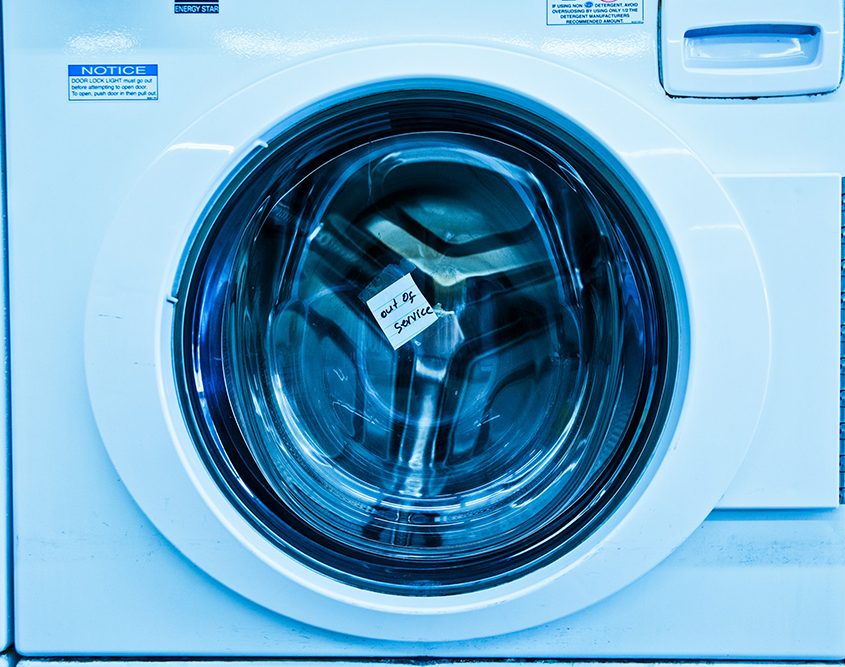Why is my washing machine making that noise?
 Has the following scenario ever happened to you? Your weekend is coming to an end, and as you prepare for the coming work week you remember you need to wash a load of clothes. You load up your washing machine like normal, turn it on, and walk away. Within minutes you hear what sounds like a marching band banging the drum in your basement or linen closet. Concerned, you rush to your washer and witness what appears to be this appliance attempting to waddle away from its typical position next to your clothes dryer. You decide to prematurely end the wash cycle, unsure of how to proceed.
Has the following scenario ever happened to you? Your weekend is coming to an end, and as you prepare for the coming work week you remember you need to wash a load of clothes. You load up your washing machine like normal, turn it on, and walk away. Within minutes you hear what sounds like a marching band banging the drum in your basement or linen closet. Concerned, you rush to your washer and witness what appears to be this appliance attempting to waddle away from its typical position next to your clothes dryer. You decide to prematurely end the wash cycle, unsure of how to proceed.
In countless homes across the United States, a washing machine is one of many appliances that homeowners typically do not think about until they either need to use it or it is malfunctioning. Considering the vast array of stressors the typical American homeowner faces on a regular basis, unexpected appliance breakdown and the subsequent need for appliance repairs represent yet another level of inconvenience and cost both in terms of time and money.
If you have ever had to ask yourself, “Why is my washing machine making that noise?”, continue reading for insight into what may be causing the issue and some preventative measures you can take.
Uneven Load Distribution
One of the most common reasons your washing machine may be making a disturbing noise is an uneven load distribution within the appliance. This type of issue is especially common with top-load washing machines as opposed to front-loading washing machines. In front-load washing machines, gravity is able to assist in ensuring the load is evenly distributed throughout the washing cycle. Wringing out clothes and redistributing them evenly within the washer is the easy and appropriate solution if uneven load distribution was the ultimate cause of the noise. If you try this intervention and still hear an uncomfortable noise coming from your washer, the issue may be hardware-related.
Faulty Tub Bearing
One mechanical component common to most washing machines is the tub bearing. The tub rests on this bearing, allowing it to move freely during the washing, rinsing, spin, and other cycles common in contemporary clothes washing appliances. If you hear a banging noise during the course of a washing cycle, and this noise seems to get louder over time, a worn-out tub bearing may be the culprit. Although your appliance’s manual provides information on how to disassemble, locate, and diagnose a faulty tub bearing, this type of appliance repair may be better handled by a reputable appliance repair service.
Faulty Drive Pulley
As we continue along our diagnostic journey from least to most complex, we arrive at the possibility of a faulty drive pulley. This component is a wheel located within the inner tub of the appliance and connected to the motor by a belt. Over time, wear and tear from routine use can cause this component to become loose, and the resulting poor connection to the appliance’s inner tub can cause significant noise. Drive pulleys on front-loading washers are typically located on the back of the appliance, while on top-loading washers this component is typically located underneath the tub. While the owner’s manual will provide guidance on how to access this component, as with the aforementioned tub bearing this type of component diagnosis and repair may be best handled by an appliance repair service.
Preventative Measures
Depending on the nature of the malfunction and the complexity of the repair, the costs of parts and labor involved washing machine appliance repair can add up fast. Thankfully, there are a number of preventative measures a homeowner can take to prolong the working life of this arguably essential appliance. Keeping the machine level is an easy intervention; most washing machine legs can turn to either raise or lower, thus providing a method of adjusting the height to ensure level seating and thus level tub seating. Additionally, routine washing of the washing machine may sound like an oxymoron, but going through a wash cycle with an empty tub and a mixture of hot water, vinegar, and baking soda will remove any debris or buildup is removed from the appliance, ensuring smooth operation. Finally, making sure not to overload the machine may be the simplest and most effective way to ensure your appliance’s tub stays quiet and properly functioning for as long as possible.
At Diamond Appliance, we’ve seen it all when it comes to washing machine issues. We proudly provide expert washing machine repair to St. Louis, Kansas City, Independence, O’Fallon, and communities across Kansas and Missouri. If your appliance is under warranty, call the manufacturer to schedule a repair – Diamond is, in fact, the favorite repair service for many manufacturers. If you do not have a warranty, give us a call.



